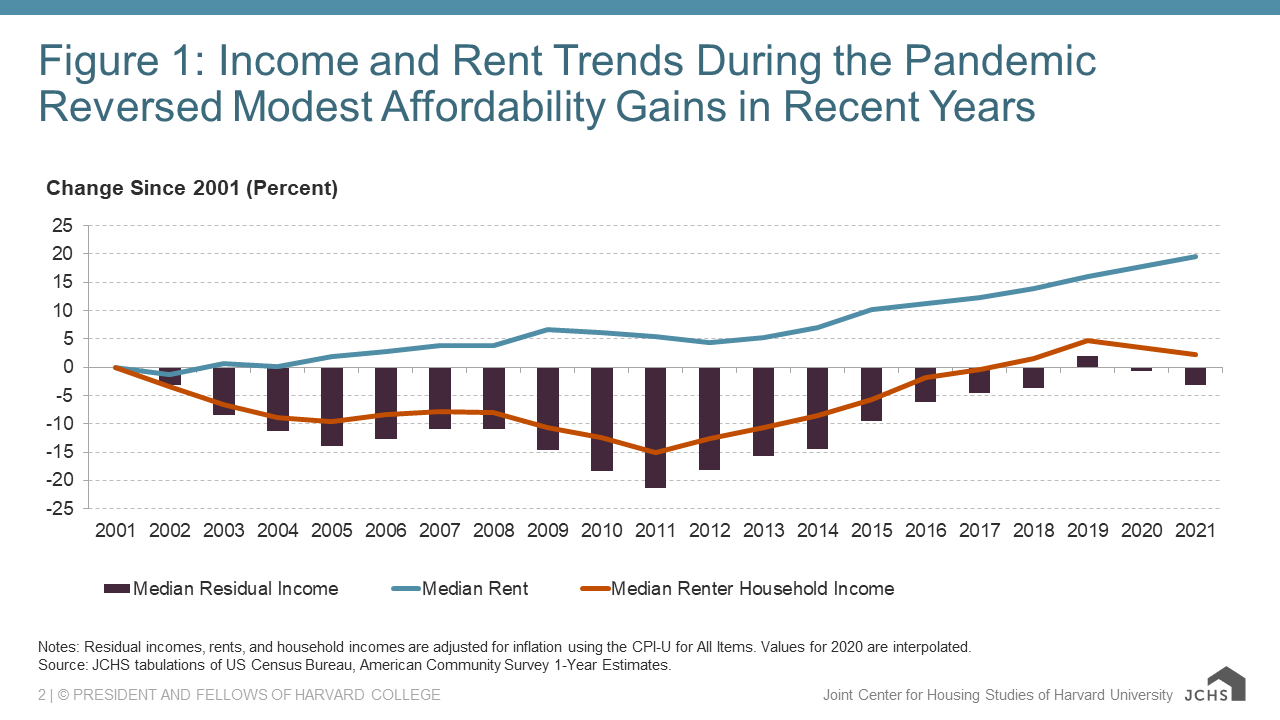 It makes sense that when rent rises and wages remain static, residual income decreases. This is the topic of a new blog post from the Joint Center for Housing Studies at Harvard University [1] (JCHS) which overall found that through analysis of the American Community Survey data, the median renter makes about $30,000 a year and after paying their monthly rent, only had about $380 of discretionary income.
It makes sense that when rent rises and wages remain static, residual income decreases. This is the topic of a new blog post from the Joint Center for Housing Studies at Harvard University [1] (JCHS) which overall found that through analysis of the American Community Survey data, the median renter makes about $30,000 a year and after paying their monthly rent, only had about $380 of discretionary income.
This number has only been decreasing, especially during mid- and post-pandemic times with this number dropping 22% than it was before the pandemic ravaged the country starting in 2020. In fact, it’s the lowest amount on record in more than 20 years.
According to the JCHS, the median monthly household income decreased 2 percent (down $85) from 2019–2021 while the median rent rose 3% ($37) in real terms. As a result, the median residual income—the amount of income left over after paying rent and utilities each month—dropped by 5% leaving renter households with $130 less each month.
Despite incomes overall increasing, renter incomes were hit harder by pandemic job losses due to the line of work renters typically are in. In addition, some higher earning renters left the renting market by moving into single-family homes. his resulted in a decline of about 279,000 renter households making at least $75,000 from 2019–2021. At the same time, there was a net gain of 223,000 households with incomes under $30,000 and just over 102,000 households with incomes in the $30,000–74,999 range. These shifts led to a $1,000 drop in the median renter household income to $43,500.

Renter incomes took a substantial hit from 2008–2011 during the height of the economic crisis, leaving median incomes 15 percent below their 2001 level. In the most recent decade, renter household incomes started catching up with rent growth but these modest gains in overall affordability were not enough to close the gap between rents and incomes.
“Falling incomes and rising rents during the pandemic eroded affordability once again, leaving renter households with less residual income,” the JCHS said. “In 2021, the median renter had a monthly residual income of about $2,450. This marked a $130 decrease since the beginning of the pandemic and was also lower than the median residual income in 2001 ($2,530) when adjusted for inflation.
“Lower-income renters have been hit especially hard by pandemic job losses amid rising rents,” the JCHS continued. “In 2021, renter households with incomes under $30,000 had just $380 left each month after paying rent and utilities. This was a decrease of more than $100 since the beginning of the pandemic and was $200 less than 2001 levels. Middle-income renters earning between $30,000 and $75,000 had substantially more residual income at $2,750 but dropped $80 since the beginning of the pandemic, and was down $220 since 2001. Even higher-income households, whose residual incomes have increased over the long term, saw their residual incomes drop during the pandemic. However, these households are more able to absorb rising rents.”
The blog post concluded that the latest trends highlight widening inequality among renters. Residual incomes for the lowest-income renter households have decreased 35% since 2021 as their incomes dropped and rent rose. Even before the pandemic, two-thirds of renters did not have enough income to cover a basic standard of living—and inflation has only added pressure to strapped household budgets.